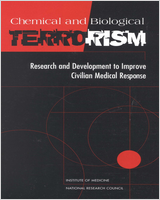From: 8, Availability, Safety, and Efficacy of Drugs and Other Therapies

Chemical and Biological Terrorism: Research and Development to Improve Civilian Medical Response.
Institute of Medicine (US) Committee on R&D Needs for Improving Civilian Medical Response to Chemical and Biological Terrorism Incidents.
Washington (DC): National Academies Press (US); 1999.
Copyright 1999 by the National Academy of Sciences. All rights reserved.
NCBI Bookshelf. A service of the National Library of Medicine, National Institutes of Health.